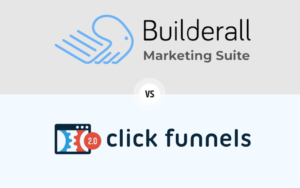We use affiliate links and may receive a small commission (for which we are deeply grateful) at no cost to you.
Key Takeaways:
I’ve tried both Moosend and TinyEmail, and I really like them for different reasons. If you need a flexible and feature-rich platform that caters to various marketing needs, Moosend is the way to go.
However, if your focus is on eCommerce and you’re looking for specialized tools to boost online sales, tinyEmail would be the more suitable choice.
Both are great choices, depending on what you need for your business. Please continue to read for more details!
Table of Contents
Introduction
When it comes to email marketing, picking the right platform is really important. In this blog post, we compare Moosend vs tinyEmail. We’ll look into what they offer, how easy they are to use, their prices, and their customer service.
Moosend is known for being easy to use and having lots of features. It’s good for all kinds of businesses and helps make email marketing simpler and more effective.
TinyEmail, on the other hand, is perfect for online stores. It uses AI to help you connect better with customers and increase sales.
Whether you’re just starting out, a marketing pro, or running an online shop, you’ll find useful info here.

Moosend vs tinyEmail: Ease of Use
When comparing Moosend vs tinyEmail in terms of ease of use, it’s clear that both platforms prioritize user-friendliness. Moosend stands out with its easy interface, making it simple for beginners to navigate and create campaigns. Its drag-and-drop editor simplifies email design, even for those with no technical background.
TinyEmail also offers a user-friendly experience, with a focus on straightforward tools for creating interactive emails. Its interface is designed to cater to eCommerce needs specifically, ensuring users can quickly launch effective campaigns. Both platforms demonstrate a commitment to making email marketing accessible, but their approaches differ slightly to cater to different user preferences and needs.
Email Design and Templates
In the Moosend vs tinyEmail comparison for email design and templates, both platforms offer robust options. Moosend shines with its diverse range of customizable templates, suitable for various industries and purposes. Its design tools are user-friendly, allowing for personalization without needing extensive design skills.
TinyEmail emphasizes interactive and eCommerce-focused designs. It provides a library of designer-made templates that are both attractive and effective for online retail communication. While Moosend offers versatility in design, tinyEmail focuses on eCommerce optimization. Both platforms ensure that users can create visually appealing and effective emails, catering to different business needs.

Moosend vs tinyEmail: Automation and Workflow
Both platforms demonstrate strengths in these areas. Moosend offers a robust automation system, allowing users to create complex, trigger-based campaigns with ease. Its workflow customization is intuitive, catering to a variety of marketing scenarios. TinyEmail, with a focus on eCommerce, streamlines automation for online retail, making it simple to set up targeted campaigns and follow-ups.
While Moosend excels in providing diverse automation options, tinyEmail specializes in efficient, e-commerce-centric workflows. Both services effectively automate email marketing tasks, but their specific features cater to different business requirements.
Integration With Other Platforms
Moosend provides a wide range of integrations with popular CRM systems, e-commerce platforms, and other marketing tools, making it a versatile choice for various businesses. This extensive integration capability allows for seamless data flow and enhances marketing automation processes.
TinyEmail, while having fewer integrations, focuses on deep e-commerce integrations, particularly beneficial for online retailers. It integrates efficiently with e-commerce platforms, enhancing the user experience for those in the retail sector.
Moosend vs tinyEmail: Personalization and Segmentation
Moosend excels in offering advanced segmentation options, allowing for highly targeted email campaigns. Users can segment audiences based on various criteria, enhancing the relevance of their communications. Additionally, Moosend’s personalization features enable sending tailored messages that resonate with individual recipients.
TinyEmail, on the other hand, focuses on leveraging AI for personalization, particularly useful for eCommerce businesses. It automates the creation of personalized content, aiming to increase engagement and conversions. Both platforms recognize the importance of personalization and segmentation in email marketing, with Moosend focusing on detailed segmentation, and tinyEmail on AI-driven personalization.
Analytics and Reporting
In comparing Moosend vs tinyEmail regarding analytics and reporting, both platforms offer valuable insights. Moosend provides comprehensive analytics, covering aspects like open rates, click-through rates, and subscriber activity. This helps users understand the performance of their campaigns in detail. Moosend’s reporting tools are user-friendly, offering clear insights for strategy adjustments.
TinyEmail also offers robust analytics. It tracks sales and customer engagement, providing users with a clear picture of their campaign’s impact on revenue. TinyEmail’s analytics are geared towards helping eCommerce businesses understand and enhance their marketing effectiveness.

Customer Support and Resources
Customer support and resources are crucial for user satisfaction. Moosend is known for its responsive customer support, offering various channels like email, live chat, and a comprehensive knowledge base. Their resources include detailed tutorials and webinars, assisting users in making the most of the platform.
TinyEmail, while newer, also provides effective customer support. They offer targeted support for eCommerce businesses, along with helpful guides and resources tailored to online retail needs.
Both Moosend and tinyEmail understand the importance of support and educational resources, with Moosend offering broad-based support and tinyEmail focusing on eCommerce-specific assistance.

Moosend vs tinyEmail Pricing and Plans
Moosend pricing plans are as follows:
- Free Trial: Moosend offers a 30-day free trial that includes all features, unlimited emails, and one automation workflow. No credit card is required for this trial.
- Pro Plan: The Pro plan’s pricing varies based on the number of subscribers, starting from 0 to 500 subscribers and scaling up to over 1,000,000 subscribers. This plan includes all features offered in the free trial but with expanded capacity and capabilities.
- Enterprise Plan: The Enterprise plan provides all features included in the Pro plan, along with additional benefits such as an account manager, priority support, SSO & SAML, and a dedicated IP. The pricing for this plan is custom and requires contacting Moosend for a quote.
For tinyEmail, their pricing structure includes:
- Shopify Pro Plan: This plan is free for all Shopify users, offering all features, unlimited usage, and 24×7 support.
- Free Plan: After the 7-day full-featured trial, users can opt for the Free plan, which includes up to 500 subscribers, forms and popups, automation emails, a limited AI subject line assistant, and other features.
- Standard Plan: The Standard plan is priced at $15 per month, providing more advanced features and capabilities.
- Pro Plan: Priced at $65 monthly, the Pro plan offers even more extensive features for businesses with higher demands.
- Enterprise Plan: Designed for large companies, the Enterprise plan offers custom pricing and is tailored to the specific needs of the business
Each platform’s pricing and plan structure are designed to cater to different business sizes and needs, from startups and small businesses to large enterprises.

User Reviews and Community Feedback
In assessing Moosend vs tinyEmail through the lens of user reviews and community feedback, both platforms have garnered distinct reputations. Moosend often receives praise for its user-friendly interface and robust automation features. Users frequently highlight its efficient customer service and the value it offers, especially for small to medium-sized businesses. On forums and review sites, Moosend is commended for its ease of use and comprehensive feature set.
TinyEmail, although a newer player in the market, has quickly gained attention for its eCommerce-focused features. Users appreciate its AI-driven personalization and the efficiency it brings to email marketing in the retail sector. Feedback often points to its effectiveness in enhancing customer engagement and sales conversions.
Both Moosend and tinyEmail have established strong community presences, with Moosend being noted for its all-around capabilities and tinyEmail for its specialized approach to eCommerce marketing. It’s evident that each platform has carved out its niche, resonating well with their respective user bases.
Moosend vs tinyEmail Conclusion and Recommendation
In conclusion, the Moosend vs tinyEmail comparison reveals two competent email marketing platforms, each with its unique strengths.
Moosend stands out as a versatile and user-friendly option suitable for a broad range of businesses. Its comprehensive features, including advanced automation and detailed analytics, make it a great choice for businesses seeking an all-in-one email marketing solution.
TinyEmail, on the other hand, shines in its eCommerce specialization. With AI-driven personalization and a strong focus on retail marketing, it’s ideal for online stores looking to enhance customer engagement and increase sales.
When choosing between Moosend vs tinyEmail, consider your business’s specific needs. If you need a flexible and feature-rich platform that caters to various marketing needs, Moosend is the way to go. However, if your focus is on eCommerce and you’re looking for specialized tools to boost online sales, tinyEmail would be the more suitable choice.
Ultimately, both platforms offer robust solutions for email marketing, and your selection should align with your business objectives and marketing strategy.
Related: Please see my post on ActiveCampaign vs ClickFunnels.

![You are currently viewing Moosend vs TinyEmail: Best Email Marketing For You [2024]](https://itsyourlifejourney.com/wp-content/uploads/2023/12/Yellow-Modern-Football-Match-Highlights-Youtube-Thumbnail1.png)
![Read more about the article Shopify vs Wix: Best Ecommerce Platform for SEO in [2024]](https://itsyourlifejourney.com/wp-content/uploads/2024/01/Best-Ecommerce-Platform-for-SEO-300x188.jpg)


Pingback: ActiveCampaign vs tinyEmail: Elevate and Drive Your Business with the Right Choice in 2024 - It's Your Life Journey